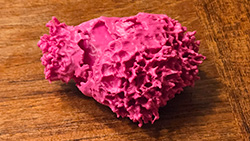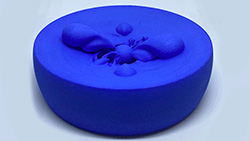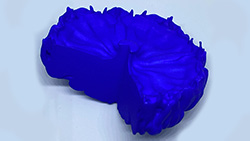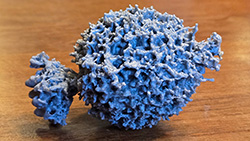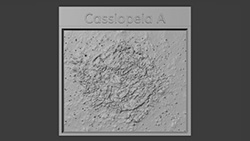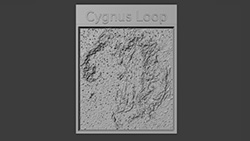CXC Home | Search | Help | Image Use Policy | Latest Images | Privacy | Accessibility | Glossary | Q&A
1
3D ModelsCredit: INAF-Osservatorio Astronomico di Palermo/Salvatore Orlando
These four models provide users the opportunity to virtually examine as well as print
stellar objects in 3D. These 3D models are based on data collected by Chandra and
other telescopes. Three of these are supernova remnants (the remains left behind after
a star explodes) and the fourth is an active, early-stage star with a disk surrounding it.
The objects in this new 3D collection are Cassiopeia A, G292.0+1.8, Cygnus Loop, and
BP Tau.
2
X-ray, Optical, & Infrared ImagesCredit: Cassiopeia A: X-ray: NASA/CXC/SAO, NASA/JPL/Caltech/NuStar; Optical: NASA/STScI/HST; IR: NASA/STScI/JWST, NASA/JPL/CalTech/SST; Image Processing: NASA/CXC/SAO/J. Schmidt, N. Wolk, and K. Arcand; G292.0+1.8: X-ray: NASA/CXC/SAO; Optical:NSF/NASA/DSS; Image Processing: NASA/CXC/SAO/N. Wolk; BP Tau: X-ray: NASA/CXC/SAO; Optical: PanSTARRS; Image Processing: NASA/CXC/SAO/N. Wolk; Cygnus Loop: X-ray: NASA/SAO/CXC; Optical: John Stone (Astrobin); Image Processing: NASA/SAO/CXC/L. Frattare, N. Wolk
This release features images of three supernova remnants and one star. Each is a composite of Chandra X-ray data along with optical data (and also infrared data in the case of Cassiopeia A). The first featured supernova is Cassiopeia A, the debris from an exploded star. BP Tau is a developing star, less than 10 million years old, and prone to outbursts or flares. These flares interact with a disk of material that surrounds the young star, forming hot loops of extended atmosphere. The third celestial object in this release is the supernova remnant called Cygnus Loop. The data examines this cloud of interstellar material interacting with the superheated, supernova blast wave.The final supernova featured in this release is G292.0+1.8. The G292.0+1.8 supernova remnant contains a pulsar moving at over a million miles per hour. Pulsars are rapidly spinning neutron stars that can form when massive stars run out of fuel, collapse, and explode. Sometimes these explosions produce a “kick,” which sent this pulsar racing through the remains of the supernova explosion.perhaps an iceberg on its side.
3
3D Printable Files: Cassiopeia A Model, 2025(3D Print Credit: NASA/CXC/SAO/A. Jubett & N. Wolk, based on a model by Sal Orlando)
In Cassiopeia A, the gas cloud is depicted as a flat disk. Bursting out the front and back of the disk is a ball, textured like coral and lined with stubby tendrils. Most of the ball, and the majority of the tendrils, appear on one side of the disk.
3D Printable Files: G292.0+1.8 Model
(3D Print Credit: NASA/CXC/SAO/A. Jubett & N. Wolk, based on a model by Sal Orlando)
(3D Print Credit: NASA/CXC/SAO/A. Jubett & N. Wolk, based on a model by Sal Orlando)
The G292.0+1.8 supernova remnant is revealed to be somewhat like a bulbous arrowhead.
3D Printable Files: BP Tau Model
(3D Print Credit: NASA/CXC/SAO/A. Jubett & N. Wolk, based on a model by Sal Orlando)
(3D Print Credit: NASA/CXC/SAO/A. Jubett & N. Wolk, based on a model by Sal Orlando)
BP Tau is a developing star, less than 10 million years old, and prone to outbursts or flares. These flares interact with a disk of material that surrounds the young star, forming hot loops of extended atmosphere. In the 3D model, the disk of material resembles a large hockey puck with round, ringed, concave surfaces. At the heart of the puck is a small orb: the developing star. Shooting out of the orb are long, thin strands: the flares. Also emerging from the orb are petal-shaped blobs: the loops of extended atmosphere.
3D Printable Files: Cygnus Loop Model
(3D Print Credit: NASA/CXC/SAO/A. Jubett & N. Wolk, based on a model by Sal Orlando)
(3D Print Credit: NASA/CXC/SAO/A. Jubett & N. Wolk, based on a model by Sal Orlando)
The Cygnus Loop model examines a cloud of interstellar material interacting with a superheated, supernova blast wave. The model resembles a bowl with a thick base, and a wedge cut from the side like a slice of pie. The sides of the bowl appear solid.
4
3D Printable Files: Cassiopeia A Model, 2023(3D Print Credit: NASA/CXC/SAO/A. Jubett & N. Wolk, based on a model by Sal Orlando)
Cassiopeia A, 2023 model.
5
3D Printable Files: Cassiopeia A Tactile Plate(3D Print Credit: NASA/CXC/A. Jubett, using software by Tactile Universe/N. Bonne & C. Krawczyk & Blender)
This tactile plate features a physical relief map of Cassiopeia A based on the intensity of X-ray light from NASA's Chandra, Infrared light from NASA's Webb and Spitzer, and Optical light from NASA's Hubble. The resulting tactile plate of Cassiopeia A resembles a disk of electric light with clouds and streaks. An area near the center of the remnant resembles a somewhat circular region of lightning. X-rays from Chandra reveal hot gas, mostly from supernova debris from the destroyed star, and include elements like silicon and iron. X-rays are also present as thin arcs in the outer regions of the remnant. Data from Webb highlights infrared emission from dust that is warmed up because it is embedded in the hot gas detected by Chandra, and from much cooler supernova debris. Hubble data shows a multitude of stars that dot the field of view.
3D Printable Files: G292.0+1.8 Tactile Plate
(3D Print Credit: NASA/CXC/A. Jubett, using software by Tactile Universe/N. Bonne & C. Krawczyk & Blender)
(3D Print Credit: NASA/CXC/A. Jubett, using software by Tactile Universe/N. Bonne & C. Krawczyk & Blender)
This tactile plate depicts supernova remnant G292.0+1.8, as a physical relief map based on the intensity of the X-ray data captured by NASA's Chandra X-ray Observatory and Optical data from DSS. The composite image depicts the remnant as a bumpy and intricate ball of X-ray gas and debris set against a backdrop of bright stars. The G292.0+1.8 supernova remnant contains a pulsar moving at over a million miles per hour. Pulsars are rapidly spinning neutron stars that can form when massive stars run out of fuel, collapse, and explode. Sometimes these explosions produce a “kick,” which sent this pulsar racing through the remains of the supernova explosion.
3D Printable Files: BP Tau Tactile Plate
(3D Print Credit: NASA/CXC/A. Jubett, using software by Tactile Universe/N. Bonne & C. Krawczyk & Blender)
(3D Print Credit: NASA/CXC/A. Jubett, using software by Tactile Universe/N. Bonne & C. Krawczyk & Blender)
This tactile plate features a physical relief map of BP Tau based on the intensity of X-ray light from NASA's Chandra X-ray Observatory, and Optical light from PanSTARRS. BP Tau is a developing star, less than 10 million years old, and prone to outbursts or flares. These flares interact with a disk of material that surrounds the young star, forming hot loops of extended atmosphere. BP Tau sits at the very center of the plate, and resembles a distant, raised dot surrounded by a band of ribbon.
3D Printable Files: Cygnus Loop Tactile Plate
(3D Print Credit: NASA/CXC/A. Jubett, using software by Tactile Universe/N. Bonne & C. Krawczyk & Blender)
(3D Print Credit: NASA/CXC/A. Jubett, using software by Tactile Universe/N. Bonne & C. Krawczyk & Blender)
This tactile plate features a physical relief map of the supernova remnant Cygnus Loop, based on the intensity of X-ray light from NASA's Chandra X-ray Observatory, and Optical light from a ground based telescope by astrophotographer John Stone. In the composite plate, the remnant resembles a wispy cloud, shaped like a backwards letter C. The 3D model examines this cloud of interstellar material interacting with the superheated, supernova blast wave.
Return to: NASA's Chandra Releases New 3D Models of Cosmic Objects (April 16, 2025)













